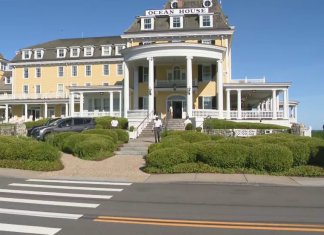On a recent Tuesday, at an event space down the block from a round-the-clock car wash, the photographer Annie Leibovitz was in crisis. “They’re bouncing off each other!” she exclaimed, pointing at two catty-corner walls, each displaying a photograph of a woman: one, a Bronx schoolteacher by a blackboard; the other, a soldier smeared with camo face paint. The images were projections, and slightly washed out. “And they’re out of focus!”
Leibovitz stood in the center of the room and put her hands on her hips—a rare moment of stillness. She was overseeing the installation of a pop-up exhibition celebrating a new, expanded edition of her 1999 book, “Women.”
“It was actually Hillary Clinton’s idea,” Leibovitz said, of the commemoration. “And I liked it. The book was out of print.” The original project consists of portraits whose subjects range from coal miners to Serena Williams, bull riders to a John-less Yoko. Leibovitz has now added a second volume, studded with celebrities from the recent past: a pregnant Rihanna, Greta Thunberg at a protest, Billie Eilish looking forlorn. The signed book, which costs $99.95, has already sold out on the publisher’s site—perhaps a relief to Leibovitz, who, in 2009, faced potential bankruptcy amid a twenty-four-million-dollar nonpayment lawsuit. “Bankruptcy is not death,” she said at the time. Apparently not.
“Can you bring up another?” Leibovitz, who is seventy-six, asked Andrew Pulaski, a screen technician. He sat at a folding table with a laptop, furiously clicking his track pad, and photographs cycled onto the wall, including one of a young Taylor Swift head-banging in a field. He landed on an image of Martha Stewart lounging on a chaise. “I really don’t like that picture,” Leibovitz said. “I was in a supermarket after, and I saw her Halloween issue, where she was made up as a witch. She was so playful, and I totally missed it.” She stepped back, as if to put space between herself and the failure.
The venue, called Studio 525, was a familiar canvas; four years ago, Leibovitz mounted “Wonderland,” her exhibition of fashion-world photographs, there. “But we didn’t use projections then—we used television screens gridded together,” she said. “I knew there was going to be a problem today.” She wore a thin down vest over a turtleneck, a pair of rectangular glasses resting on her slender nose. “I’m going to work on the image choreography,” she announced, darting to a back room.
Other crises were brewing. Leibovitz still had to edit her speech for the opening party, the following night. In the back, she thumbed a stack of highlighter-dotted papers. “ ‘How we are seen no doubt changes how we see ourselves.’ Gloria Steinem said that,” she read aloud, slowly rolling over the words. She paused. “That’s the fucking line. I’m gonna say that, then I’ll go, ‘Susan Sontag and I collaborated on the first one.’ ” Sontag, the late critic and Leibovitz’s longtime partner, wrote the book’s original introduction. “Susan . . . whew,” Leibovitz said. “She was in the middle of chemotherapy. I read it now, and it’s just so Susan. There’s a whole passage about Greta Garbo.” She let out a hearty chuckle.
Leibovitz moved on to the guest list. “Did you invite Frances McDormand?” she asked her agent, Karen Mulligan.
“She’s in California,” Mulligan replied.
“She’s upstate,” Leibovitz’s editor, Deb Aaronson, corrected.
“Is Hillary coming?” Leibovitz asked, retrieving a lox-and-tomato bagel from a brown bag. Clinton also had a hand in inspiring the original “Women”—Leibovitz cites her 1995 speech in Beijing as a light-bulb moment. “She said, ‘Women’s rights are human rights,’ and it went viral,” she recalled. “That was in my slide show for tonight.” Leibovitz had planned to give a talk at the Brooklyn Paramount that evening, but the city had other plans. “If you put it on Election Day, you’re cursed,” she said, unbothered. “We were bumped out of there for Mamdani’s party.” (A few clueless Annie fans still showed up, unaware of the last-minute switch.)
Pulaski popped his head in: “I want to see if you like this.” Leibovitz hoisted herself up from the velvet chair she was in (“Ugh, right leg,” she grunted) and followed his squeaky sneakers out to the main space. A photograph of a policewoman filled one of the walls.
“It’s great,” she said, her voice echoing. “Everything looks a lot better right now.”
By the next night, all the images were clear, the folding tables were gone, and the tequila was flowing. “I’m satisfied,” Leibovitz said, surveying the bustling room. Her muses wandered through the gallery. Martha Stewart admired the image of Martha Stewart. Fran Lebowitz got trapped in a conversation about luxury goods. Frances McDormand did not make it down from upstate, but Gloria Steinem did make it down from the Upper East Side. An event photographer scurried around carrying a large light reflector. He was trying his best to wrangle the big names, but it wasn’t easy: “Heavy hitters like these, they don’t like their picture taken.” ♦







